|
A
Lincolnshire
posy
and
a countryside
bounty |

|
The decline in our wild flowers in recent years is a continuing disappointment for those
who love the spring because it is at this time of year when they are at their best. But the disappearance of old hay meadows and
traditional grassland, the widespread use of farm chemicals, industrial and
residential encroachment and the illegal digging up of plants for private gardens, has drastically reduced their natural habitats and so it is a delight to find those secret places
around Bourne where they still thrive, their annual life cycle uninterrupted by the hand of man, their worst enemy.
|
Beefsteak fungus growing in Bourne Wood |
|
 |
The smell of damp and mushrooms pervades the
autumn air in Bourne Wood and various varieties of fungus abound
but it is best not to pick them for eating without expert
knowledge because some are extremely poisonous. We found this
large beefsteak fungus (Fistulina hepatica) alongside one of
the more secluded paths but we decided not to pick it although checking my reference books at home revealed that it is edible,
even when raw, but in this case one should drain off the liquids
exuded when dressed. |
|
Yellow loosestrife near Bourne Wood |
|
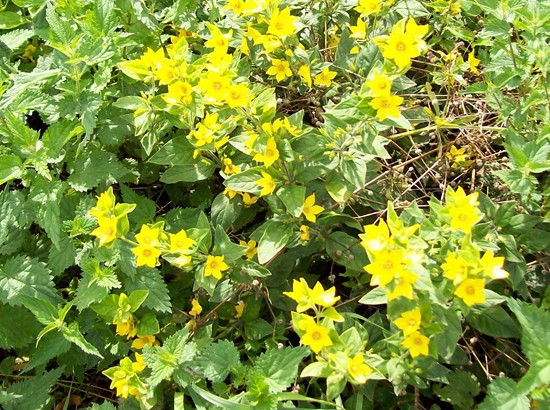 |
|
Yellow loosestrife can be found in many
wayside and waste places and these delicate
five-petalled flowers can be
found in abundance on the margins of Bourne Wood, especially at
the Beech Avenue entrance where despite competition from
encroaching nettle beds they thrive as a welcome to walkers for
many weeks during the summer months. These tall, erect and
handsome plant (Lysimachia vulgaris) can be found along
shady riverside banks and other damp places in July and August,
often growing up to 4 ft. high, but it has a creeping root which
persists year after year which is perhaps why it is not favoured
by the more dedicated gardener.
It also has many medicinal properties and has therefore been
popular with country folk for centuries, notably to stem bleeding
from a fresh wound, a treatment even recommended by the herbalist
and physician Nicholas Culpepper (1616-64), and to quieten unruly
beasts such as plough oxen by placing sprigs underneath the yoke
and so relieve them of the torment from gnats and flies which find
it obnoxious, and for this reason the dried herb was often burned
in houses to keep such pests away and was therefore popular in
marshy districts such the fens. Gardeners of old have suggested
that yellow loosestrife can be attractive in the domestic plot
where they will thrive if the soil is moist although their
perennial roots do spread and perhaps the neighbours might not
approve of the intrusion. |
|
Snowdrops growing in
the town cemetery |
|
 |
|
Wild arum growing in the churchyard at
Bourne |
|
Wild arum (Arum maculatum) has
many country names including Lords and Ladies, Jack in the
Pulpit, Devils and Angels, Cows and Bulls and cuckoo-pint,
so illustrating that it is a common woodland plant, a
species of the araceae family. The purple spotted
leaves appear in the spring followed by flowers born on a
poker or spadix but they fade by autumn to form a
cluster of bright red berries which are extremely poisonous
and should never be eaten. |
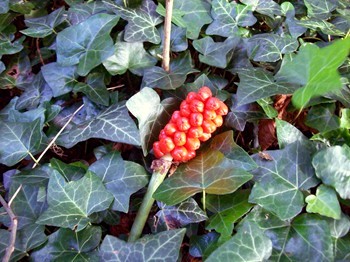 |
|
|
Spring flowers have
colonised our graveyards because they have been planted around
tombstones over the years by grieving relatives and friends.
Snowdrops (Galanthus nivalis) are the first to appear as
harbingers of spring, closely followed by primroses, lesser
celandines and daffodils, and their appearance is an indication of
new life amid so much death and if those departed could speak,
they would surely welcome this unexpected floral display around
their last resting place. Snowdrops are also known as Candlemas
Bells because of their flowering time in February (Candlemas is on
February 2nd) and patches of them can be found each year in Bourne
town cemetery where conditions are particularly conducive to the
snowdrop which readily becomes naturalised and soon spreads over
large areas under trees and between graves. |
|
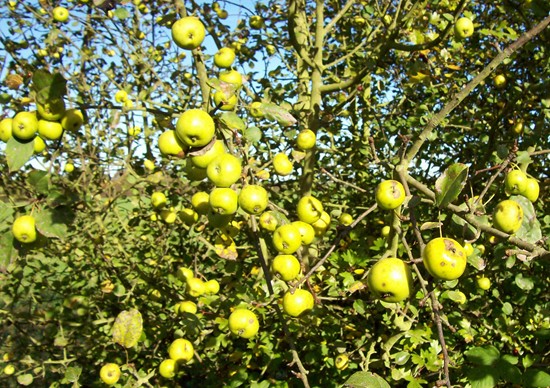 |
|
Crab apples in the hedgerow on the Greatford road near Carlby |
|
The pinkish white blossom of the crab apple
tree, the parent of all cultivated apples, enlivens hedgerows in
spring and in autumn its leaves turn gold while its fruit, small
and greenish-yellow, often tinged with red, has a hard and woody
texture and a sour taste. But crab apples make a delicious jelly
which is always welcome on the table and so the fruit is picked by
those who know the secret of this culinary delicacy. The
crab apple (Malus pumila) derives its name from the Old
Norse word skrab, meaning a small rough tree. It seldom
grows above 30 feet and lives for up to 50 years, those found in
hedgerows often having sprung from the seeds of orchard apples
that have reverted to ancestral type. Apples of some sort were
abundant in Britain before the Norman Conquest and were probably
introduced by the Romans. Twenty-two varieties were mentioned by
Pliny and there are now about 2,000 cultivated kinds. |
|
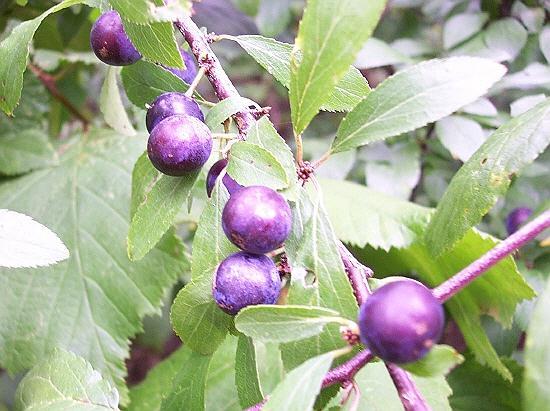 |
|
Sloes growing in
Bourne Wood |
|
Sloe gin comes from the
blackthorn, a shrubby tree up to 12 feet high, often seen in
hedgerows, and is among the first to flower in the spring. The
Latin name, Prunus spinosa, means literally "spiny plum"
and it belongs to the rose family but is an ancestor of our garden
plums. Each flower has five white petals and after
pollination, a stone fruit is formed, a sloe with a tough
blue-black outer skin covered with a white waxy bloom. Sloes
mature in October and are intensely bitter but ample sugar added
to their pulp makes a tasty jelly although they are picked more
for sloe gin, a potent drink produced by steeping them in gin to
which they give a piquant flavour. Birds are also partial to the
flesh of the sloe and drop or swallow the hard, indigestible seed,
thus ensuring the spread of the species and once established,
thickets persist indefinitely, expanding by means of sucker shoots
from the roots. |
|
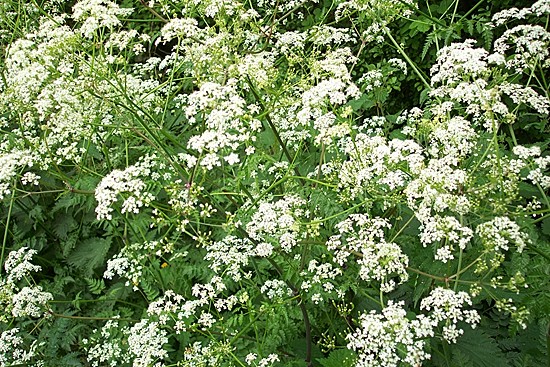 |
|
Cow parsley growing
at the Beech Avenue entrance to Bourne Wood |
|
During May and June,
our roadside verges are fringed with walls of white as cow parsley
comes into flower, its strong and bitter sweet smell filling the
air as a reminder that spring has arrived for another year. Fern
like foliage supports the broad heads of tiny petalled flowers of
this tall and downy plant and although there are several species,
cow parsley (Anthriscus sylvestris) is the most common in the
Bourne area although you will also find sweet cicely in many
places. The botanical name is Umbelliferae because most of the
seventy or so British species are arranged umbrella-like on ribs
that spread from a central stem. Cow parsley, sometimes known as Queen
Anne's lace and hedge parsley, can also be found on the edges of
woods and in coppices and is known in some areas as kek.
Children used to make pea shooters and whistles from the stout,
hollow stems, a countryside tradition that is little known today. |
|
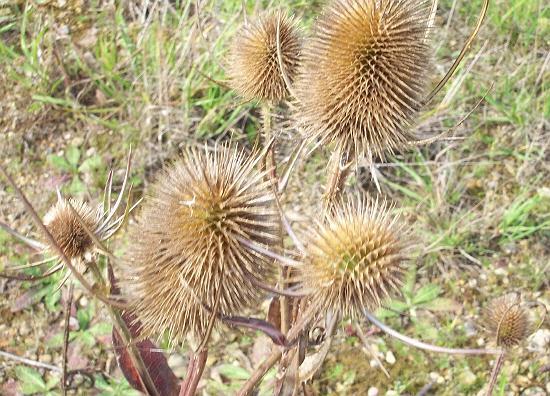 |
|
Teasel growing on
the edge of a gravel pit at Baston Fen |
|
Teasel is a prickly
biennial, a striking plant with large, spiny heads that fill with
water in rainy weather, often drowning small insects that nest
there, and it has been speculated that the plant could benefit
from them because it might be carnivorous, although some tropical
flowers use similar water traps to protect their flowers from
insect attack. In summer, they produce a mass of rose-purple
blooms amid small, narrow leaves but by September they are quite
dead yet still retain their perfect shape which is so attractive
in vase arrangements and provide food for goldfinches through the
winter. Teasel (Dipsacus sylvestris sylvestris) is the most
common species in Britain and I photographed these growing on the banks
of a disused gravel pit at Baston Fen, near Bourne, which appeared
to be a particularly suitable environment because they thrive in
grassy places and at the riverside. The spiny heads have long been
used to raise the nap on velour or cashmere, no machine or
manufactured hand tool having been invented to do the job better. |
|
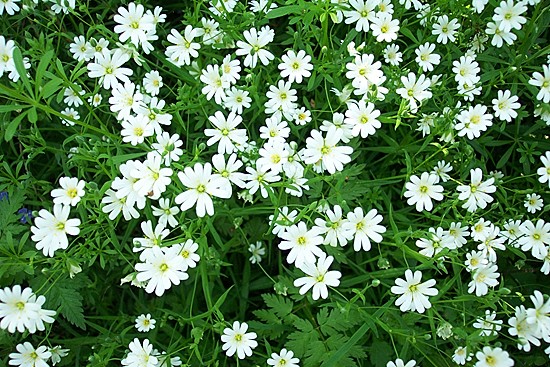 |
|
Greater stitchwort
growing in Dole Wood, May 2006 |
|
When the bluebells have
faded in Dole Wood each spring, the greater stitchwort takes over,
changing the colour of the woodland floor from blue to white. It
is a ubiquitous plant, slender with flowing stems and with a mass
of white flowers, the petals notched to about half their length,
and you will find them here between May and June. The
thread-like lower part of the stem looks impossibly thin and
supports the plant only with the help of its neighbours and so it
thrives amid the lush vegetation of the secluded glades. Greater
stitchwort (Stellaria holostea) was known for its medicinal uses
and the seeds were powdered together with acorns, added to wine
and used to alleviate the "stitch" or similar pains in the side,
hence the name. |
|
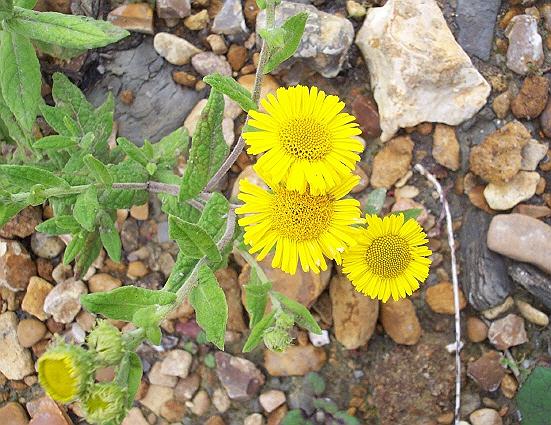 |
|
Common fleabane
growing on the edge of a gravel pit at Baston Fen |
|
A familiar yellow
daisy-like plant known as common fleabane can often be found in
places where there is standing water, preferring moist meadows and
the banks of ditches, brooks and rivers, growing in masses and
frequently over-running large tracts of land on account of its
creeping underground stems. This picture was taken at the private
nature reserve in Baston Fen, five miles south of Bourne, owned by
farmer Nicholas Watts and containing two disused gravel pits that
have attracted a wide variety of plant, animal and bird life.
Common fleabane (Pulicaria dysenterica) is so named because
it was once used to repel fleas and the stems of the plant were
strewn on the floors of houses for this purpose. Dried and burned,
it acted as an insecticide against midges and the plant also has
medicinal properties, once being used to treat dysentery. |
|
Yellow flag growing
at St Peter's Pool in Bourne |
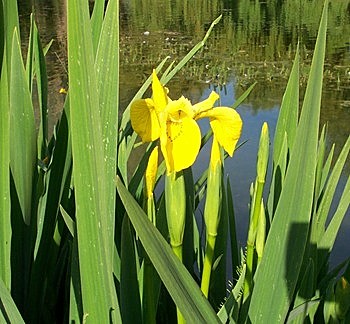 |
Two species of wild
iris are native to Britain, each flowering from May until late
July, the most common being yellow iris or flag (Iris
pseudacorus) which flourishes in wet woods, damp meadows and
at the side of ponds, such as here on the fringes of St Peter's
Pool where they add a stately beauty to the waterside. It grows up
to 2 ft. high and has sword shaped, grey-green leaves with raised
midribs. The stout, branched stems bear two or three bright yellow
flowers which appear one at a time. Yellow flag has many other
evocative names, such as Dragon Flower, Jacob's Sword and Daggers
but it's resemblance to a waving flag provides the most popular. |
|
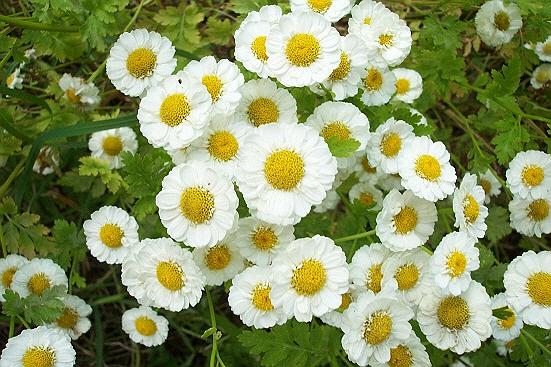 |
|
Feverfew growing on
waste ground near the entrance to Bourne Wood |
|
Some of the most
attractive of our wild flowers can be found growing in secluded
places where they flourish untouched and often
unseen. I found this patch of feverfew (Chrysanthemum
parthenium) on waste ground alongside the Beech Avenue
entrance to Bourne Wood in July 2004 where passers-by treated it
as a weed. Feverfew is a perennial growing to about 18 inches tall
and is commonly seen at the roadside, on walls and in old
churchyards, with deeply cut dark green leaves and clusters of
daisy-like yellow centred white flowers, between July and
September. The name feverfew is a corruption of fibrifuge,
a substance which puts fever to flight and was probably introduced
from Europe in the Middle Ages by mediaeval herbalists. It is
highly aromatic and often grown for ornament or medicine, the drug
it contains being once used to reduce high temperatures and cure
headaches, particularly migraines. The strong smell comes from the
leaves and many people find it unpleasant. |
|
 |
|
Honeysuckle growing
in Bourne Wood |
|
One of the most
frequent and popular woodland flowers is the honeysuckle (Lonicera
periclymenum) that proliferates in Bourne Wood, clinging to
tree trunks and sometimes climbing to a height of twenty feet and
more. It flowers between June and October, producing compact,
creamy, trumpet-shaped heads, often flushed with red or purple and
its heavy sweet scent make it a popular transplant for gardens
although it can soon run out of control unless severely pruned
back. It is equally conspicuous in autumn with its clusters of
crimson berries. Night flying moths are attracted by the scent,
which is strongest at dusk, and pollinate the flowers as they seek
nectar. There are 300 varieties of honeysuckle and many have
medicinal properties, most famously as an aphrodisiac, and are
still regarded by the Arabs as an excellent restorative while the
roots, if eaten, are reputed to be good for the liver, to ease
cramps and convulsions. |
|
Nettle-leaved bellflower growing on the
outskirts of Bourne Wood |
|
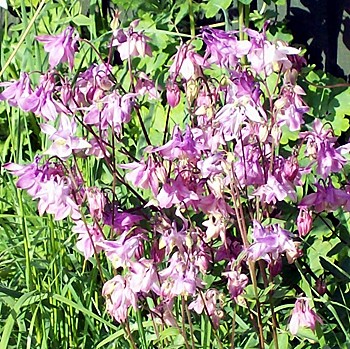 |
We found these attractive flowers growing
alongside a fence between the garden of a house in Beech Avenue
and the woodman's yard on the outskirts of Bourne Wood, a mass of
blooms amid a tangle of grass and weeds. The nettleleaved
bellflower (Campanula trachelium) is a tall plant of
woodland margins such as this and adds a splash of colour to any otherwise dull
location, with toothed, nettle-like leaves and a spike of bluish
bell-shaped flowers that catch the attention of woodland walkers
as they leave. The plant also has medicinal properties and was
widely used in past times for treating throat infections. |
|
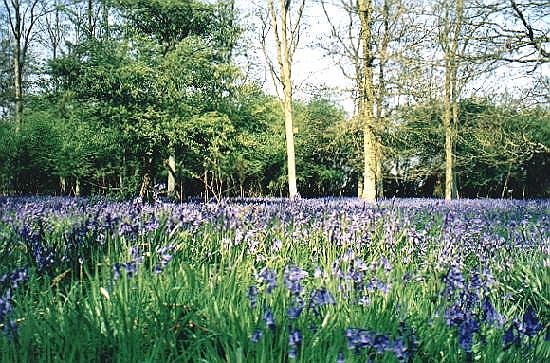
|
|
Bluebells growing in
a secluded glade in Bourne Wood |
|
The appearance of bluebells is a sign of an ancient woodland and many such sites can be found around Bourne. They grow in profusion in Bourne
Wood, in Dole Wood and at
Callan's Lane near Kirkby Underwood where their nodding, bell-shaped blue flowers carpet the forest floor every spring. The bluebell
(Endymion non-scriptus) blooms from late April until early June and then survives for the rest of the year as a small, white, juice-filled bulb, about six inches below the surface of the ground, awaiting for the next spring when a succulent stem rises from it to a height of 12-18 inches, surrounded at ground level by long, strap-like leaves. In Scotland they call it the wild hyacinth the famous bluebells of Scotland actually being a harebell, and the bluebells we see in gardens are not actually the delicate wild species but a bigger and coarser variety that is a native to Spain and Portugal. |
|
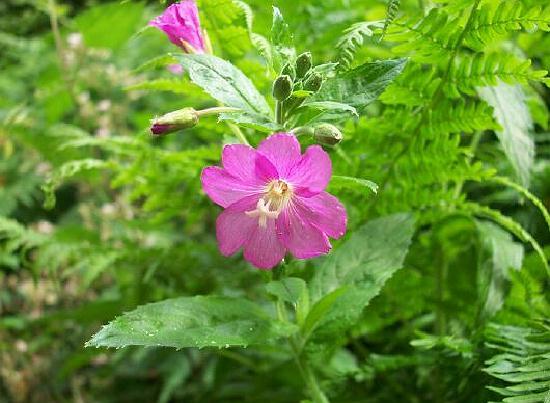 |
|
Great willowherb
growing alongside a footpath in Bourne Wood, July 2005
|
|
Great willowherb (Epilobium hirsutum)
is tall and softly hairy and is usually found in damp places such as
marshes, the banks of ponds and the margins of lakes, rivers and
streams. It stands erect and flowers in July and August and
appears in deep purplish-pink clumps that can be seen from a
distance. The leaves, and particularly the top shoots, when
slightly bruised, have a delicate and cool odour resembling
scalded codlings, hence its popular name of Codlings and Cream,
but this fragrance is soon lost after the plant is gathered. It is
also called, in allusion to this delicate scent, Apple Pie, Cherry
Pie, Gooseberry Pie, Sod Apple and Plum Pudding, and is believed
to be St Anthony's herb of antiquity. |
|
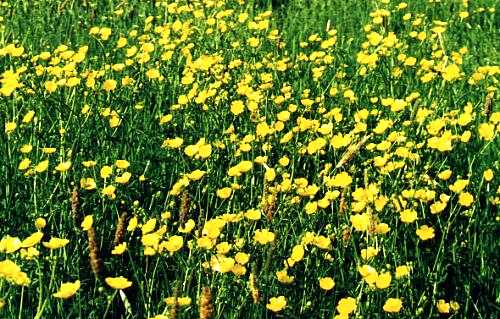
|
|
Buttercups growing
in meadow just off the A151 west of Bourne. |
|
There was a time when buttercup meadows were a familiar sight in the countryside but there is now no place for them in areas of intensive farming such as that around Bourne where they have been killed off by the repeated use of herbicides. The buttercup
(Ranunculus acris) however is one of nature's survivors and remains one of our most familiar summer flowers because it can be seen
at this time in some fields and more especially along roadside verges, springing from dormant roots and spreading over the springing turf, eager to set seed before they are overshadowed by tall, lush
grasses. They are a sign that the countryside is coming alive and not even late frosts will stop the new growth. The rich yellow of the cup-shaped flowers is associated in folklore with the yellow butter that comes from the cattle that grazed the pastures and a favourite trick
of childhood in past times was to pluck a buttercup and hold it under a friend's chin and if it
reflected the yellow colour on to the skin, which it invariably
did, then this was declared to be a sign that they like butter. Who would have thought that the day would come when the simple buttercup would be exterminated wherever possible by agro-chemicals? Ah, those halcyon days of youth and innocence.
|
|
Yellow archangel
growing in Dole Wood, May 2006 |
|
Often mistaken for a
nettle, this rather stiff and hairy plant is a close relative of
the white deadnettle but does not sting. It can be found on rich,
damp soil in woodlands and shady hedgerows and reaches a height of
two feet with long creeping runners that spread out and take root
in all directions, producing extensive patches with little else
growing in between. From May to July, yellow archangel (Galeobdolon
luteum) produces flowers with an upper lip forming a distinct
hood of bright yellow with darker streaks and provides a splash of
colour in the lush undergrowth. The plant gives out a strong odour
when crushed and had a reputation in times past for healing sores
and ulcers. |
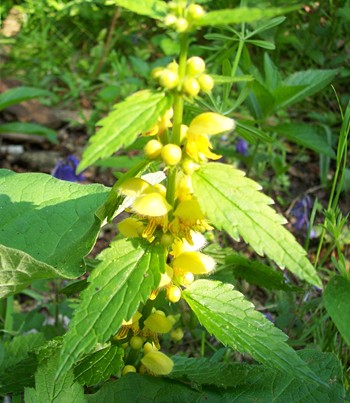 |
|
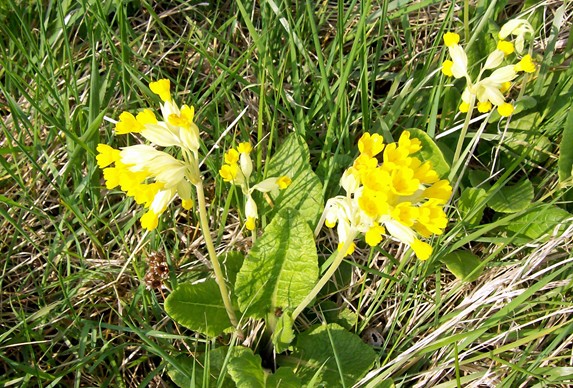 |
|
Cowslips on a stretch of roadside verge
near Manthorpe |
|
The cowslip
(Primula veris) comes from the same family as the primrose and also had similar uses.
They once grew in abundance in many places, especially along
roadside verges but are now a rare sight because they have become
a victim of both farm chemicals and of plant collectors who take
them to decorate their gardens and so deprive us of their
countryside beauty. The name cowslip is a polite form of cowslop or cowpat, referring to its occurrence in scattered clumps in cattle pasture land. The flowers
when collected in full bloom during April or May make a wine which was once recommended as a cure for insomnia while an ointment
they produced was claimed to cure spots and wrinkles. Cowslips, like primroses, are a protected species and it is now illegal to pick them or dig them up and yet there
seem fewer about now than in previous years. Are the vandals still
abroad in the countryside? However, several patches can be found on the wide grassy verges
around the Bourne area, especially on the back road between Greatford and Belmesthorpe, nodding their dainty heads in the gentle breeze of a sunny April
morning to make your journey well worthwhile. |
|
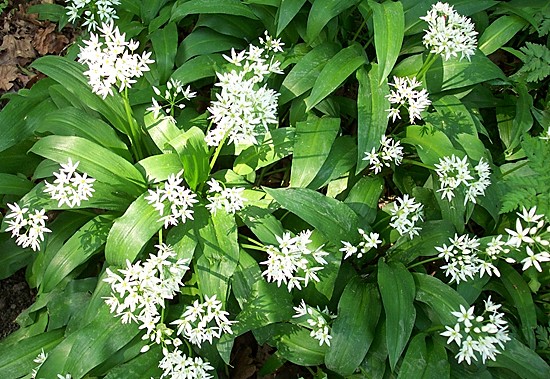
|
|
Ramsons growing in
Dole Wood, near Bourne |
|
The pungent smell of garlic meets visitors as they enter Dole Wood, near Bourne, each spring. Large clumps of ramsons
(Allium ursinum) abound and there are so many near the shaded entrance to the wood that they carpet the floor with white. Ramsons
advertise themselves by this overpowering smell of garlic, hence
the common name of wild garlic, and there has been speculation that long ago
they was used as well as, or in place of, onions for the table although cooking diminishes the smell. Country folk also say that bread made from wheat cut from the damp edges of fields very often had a not unpleasant taste of onions because the reaper had scythed up a fair proportion of ramsons and never bothered to clean them out. With their long shiny leaves and clusters of white star-like flowers, ramsons make a pleasant backdrop to the bluebells for which Dole Wood is famous. |
|
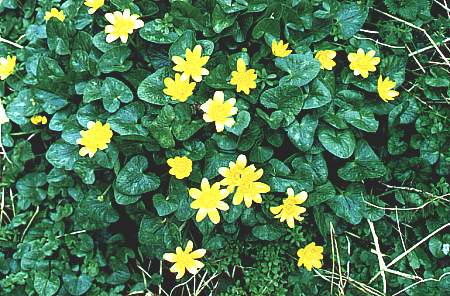
|
|
Lesser celandines growing by the roadside at Edenham, near Bourne. |
|
The lesser or small celandine can
be seen in early March while driving out to the villages, in damp and shady places, shyly peeping through the greenery along the moist banks of dykes and streams, its glossy foliage forming a dense carpet. It is one of the very earliest of our spring flowers, its cheery, star-like heads lighting up our roadside verges even before the winter is quite spent. William Wordsworth recognised the lesser celandine (Ranunculus ficaria) as a harbinger of spring and suggested that the painter who first tried to picture the rising sun must have taken the idea of the spreading, pointed rays from what he called the celandine's "glittering countenance". It became his favourite flower and its blossoms are carved on his tomb and in 1804, while living at Dove Cottage near Grasmere in the Lake District, he wrote:
There is a Flower, the lesser Celandine,
That shrinks, like many more, from cold and rain;
And, the first moment that the sun may shine,
Bright as the sun himself, 'tis out again! |
|

|
|
Early purple orchids
growing alongside the Yew Tree Avenue at Clipsham |
|
The early purple orchid (Orchis
mascula) flowers in the spring and can be found in moist woods and grassland and so it was appropriate that we found these examples growing on the bank of a narrow drainage ditch although they are also often
seen among bluebells in ancient woodland. These are delicate lilac-coloured flowers, rising on long stalks from a pair of strap-shaped fleshy leaves, black-blotched on their dark green surface. It is these leaf spots that can cause confusion with the common spotted orchid but this species mainly
appears in June.
The flowers of the early purple orchid are most attractive but they do have the unlovely smell of tomcats. There is another feature of this unusual
species that engages the attention because the twin tubers resemble testicles and so this orchid was used as an aphrodisiac whilst the name orchid actually comes from the Greek for testicle.
There is a fascinating archive of folklore and herbal use that has built up over the centuries when our wild orchids flowered in abundance each spring. We now look in vain for
them every year and as the variety of flora and fauna that we once knew in our countryside continues to recede, it is quite likely that in the very near future, the only contact we can have with them will be from books and photographs. |
|
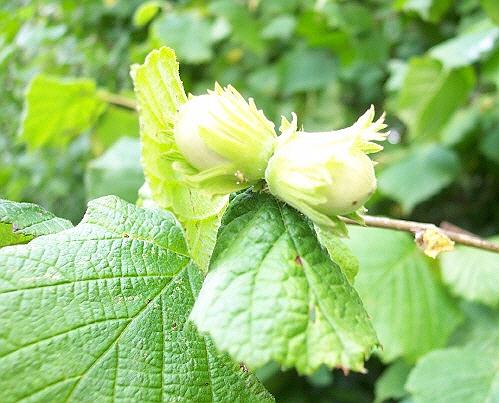 |
|
Hazelnuts in Bourne
Wood |
|
There is an edible bounty
in fruit and nuts from Bourne Wood that is collected annually,
ranging from rose hips and blackberries to sloes and crab apples. In
past times, before the arrival of the supermarket culture, there was
a race to pick them when they were ready because food from the shops
was expensive and so additional nutrition from the countryside for
the price of a little physical effort was welcome for families on
low incomes. Hazel (Corylus avellana) is widely distributed
in Europe and can be found in woods, thickets and hedgerows, growing
to around 12 metres, although often shorter and usually a broad
bush, sometimes with a short trunk. The bark is a smooth and shiny
grey-brown and the female flowers begin as small brown buds with
protruding crimson stigmas, developing into clusters of one to four
nuts, each partly enclosed in a toothed green husk, and changing
from whitish green, as pictured above in mid-summer, to pale pink
brown and finally brown by the autumn when they are ready for
picking. October is the best month, a time of wayside nibbling and
sampling, because hazelnuts are then at their prime and although it
would be a simpler task to buy a packet from Sainsburys or Rainbow,
paying for them at the checkout will not give you the same pleasure
as seeking them out in the wild and of course, they will taste that
much better. |
|
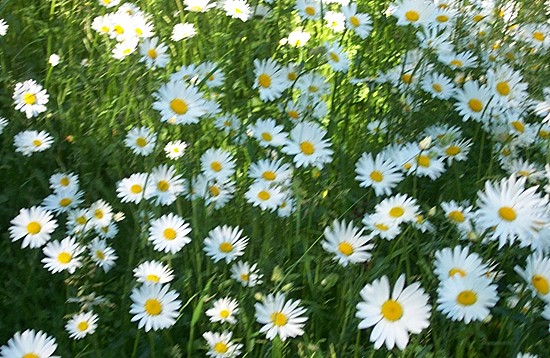 |
|
Dog daisies
in Bourne Wood |
|
Among the most familiar of all summer flowers are the large white daises adorning meadows and waste ground and mile after mile of roadside and railway embankment. The oxeye
or dog daisy
(Leucanthemum vulgare) has a long unbranched stem making it
a favourite ingredient in a bunch of wild flowers of times past
before picking such blooms was outlawed. We found this clump growing
in Bourne Wood, their heads turned to the sun because they love the
light, closing their petals in bad weather and after dark, hence
their name which is a contraction of day’s eye. It is related to the
Shasta Daisy, originally from the Pyrenees and widely cultivated in
gardens although the daisy family is enormous with some 25,000
species. This perennial thrives in grassy places around the countryside from June to August and has large yellow-centred white daisy-like heads that can be smaller in exposed places. It has various medicinal uses and the ancients dedicated this flower to Artemis, the goddess of women, because it was considered to be useful in women's complaints.
During the Middle Ages, the Crusaders made an ointment from the
daisy plant which they used to treat bruises, broken bones, and
wounds. It was also used for catarrh and migraines. When made into a
decoction, daisy was considered to be a remedy for rheumatism, and
bronchitis and the leaves were also chewed to cure mouth ulcers
while a superstition also existed that eating three daisy heads
after having a tooth pulled alleviated toothaches forever. Country people
were also known to take an infusion in their ale as a cure for jaundice. |
|
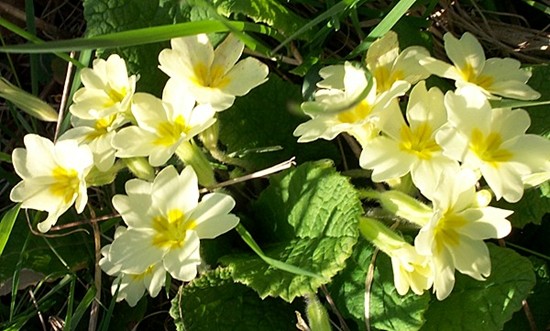 |
|
Primroses in the
village churchyard at Irnham, near Bourne
|
|
Primroses have always been
a well-loved wild flower in England and were once planted on graves
which is probably how they arrived in so many churchyards over the
centuries. They were once highly regarded for their medicinal
properties and during mediaeval times, an ointment made from
primrose leaves boiled with lard was used by woodsmen in the New
Forest to treat cuts while on May Day, bunches of primroses were
laid on the floor of cowsheds to protect cattle from witches at a
time when they were considered to be at their most active. In the
west of Britain the primrose (Primula vulgaris) begins to flower
soon after Christmas and by this time of the year it can be seen in
the woods and hedgerows, along the banks of waterways and in old
grassland throughout the country, the best place in this area
probably being St Andrew’s churchyard at Irnham which has a grand
display most years. However, do not pick them because the primrose
is a protected species yet is often scarce near towns because of the
number of people who have selfishly transferred them to their
own gardens. The plant grows 2-8 inches high and has a rosette of
bright green, corrugated leaves with pale yellow flowers and deep
contrasting centres, although sometimes, but less often, they have
pink flowers. They are among the most delicate of our spring blooms
with a fragility that is fleeting which is why we should treasure
the primrose while it lasts. |
|
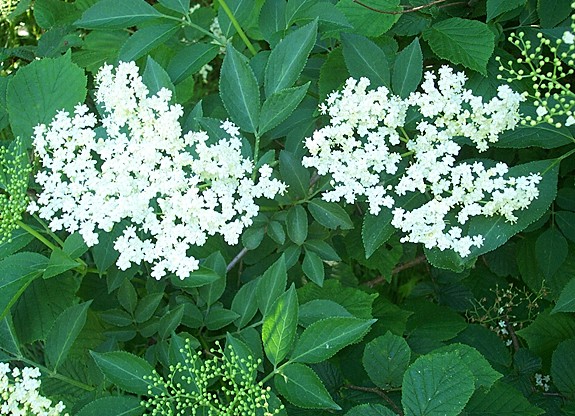
|
|
Elder flower growing
at the roadside near Lound, south of Bourne (above) and
elderberries in Baston Fen (below).
|
|
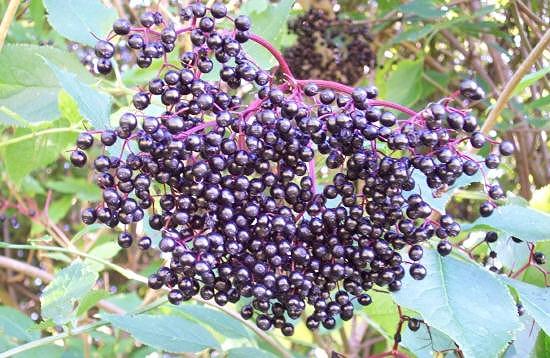 |
|
Elderberries at the
roadside near Bourne |
|
Elder flower is small,
bright and creamy-white and one of our most prolific blooms to be found in the countryside at springtime. The flat-topped clusters have a bitter sweet fragrance and although many people profess a strong dislike of the smell, the elder
(Sambucus nigra) is generally beloved by all who see it because it is one of the most familiar and attractive features of our hedgerows while its olde worlde associations have won a place in the hearts of English people.
It has been said with some truth that our summer is not here until the elder is fully in flower and that it ends when the berries are ripe. The word elder comes from the Anglo-Saxon word
oeld or fire, the hollow stems of the young branches having been used for blowing up a fire. The soft pith pushes out easily and the tubes thus formed were used as pipes, hence it is often called a pipe tree and as young lads of my generation knew they were also perfect for use as pea shooters or pop guns.
A wealth of folk lore, romance and superstition surround the elder, the most familiar tale being that the Cross of Calvary was made of this wood and in consequence it has become the emblem of sorrow and death. But despite these traditions, the elder has a firm claim on the popular affection for its many sterling virtues and its uses are manifold and important. The wood of old trees is white and fine and polishes well and has many uses for such articles as skewers and pegs. The leaves when bruised and worn in the hat or rubbed on the face will keep the flies at bay while the bark, flowers and berries are all reputed
to have numerous medicinal uses and the recipes for such culinary delights as elder flower vinegar, elder wine, elderberry jam, chutney and ketchup, are legion and still produced in many country kitchens. |
|
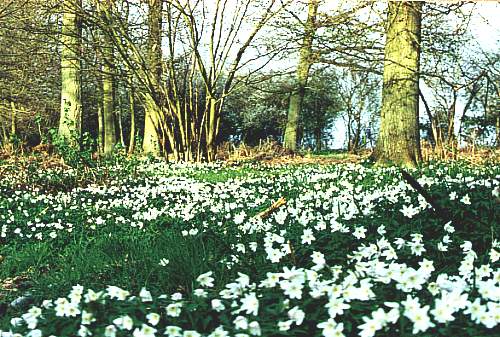
|
|
Wood anemones can be
found in profusion in Bourne Wood during April |
|
The wood anemone (Anemone
nemorosa), also known as crowfoot and windflower, is a many petalled bloom of white, tinged and veined with purple, the main leaves of the plant rising from the ground only after flowering is completed. The
blooms open wide in bright sunshine and then close as night falls, so ensuring that the dew will not settle and cause damage and there is a similar reaction when rain threatens during the daytime.
This plant is also the subject of much folklore and the Romans plucked the first anemones as a charm against fever and the practice has survived in some remote districts where it is picked with the words: "I gather this against all diseases" and then tied around the patient's neck. Greek legends say that Anemos, the Wind, sends the anemones in the early spring days as a herald of his coming and that they only open when the wind blows, hence their alternative name of windflower.
One British naturalist claims that it flowers at the same time as the return of the swallow, yet few
of these birds are to be seen here in South Lincolnshire at this time of the year while another expert who was recording the days on which it came into bloom, found that the wood anemone never blossomed earlier than March 16 and never later than April 22, observations that were made each spring for a period of thirty years. |
|
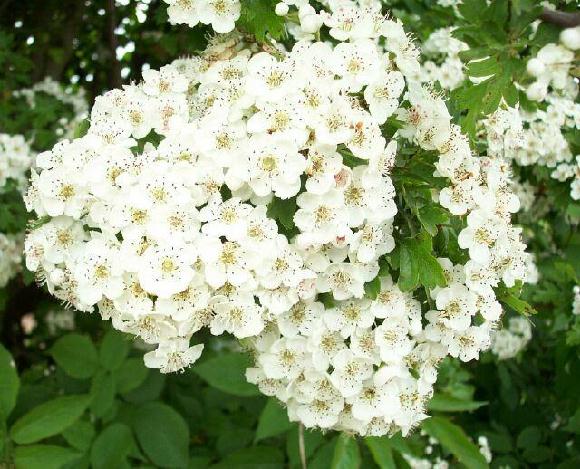
|
|
May blossom growing
along the old Bourne to Spalding railway track
|
|
May is the month when Mother Nature paints the hedgerows white with blossom and we can see it in profusion and sample its bitter sweet smell wherever we go. It is at its most prolific in the thickets and hedgerows that line the fields and meadows between Bourne and Stamford and along the route of old railway lines where the hawthorn trees have been left unattended since the services closed down. We see these hawthorn trees in such profusion because they were often planted as windbreaks and boundary hedges and they can reach a height of thirty feet and live to a great age and in addition to this utilitarian purpose, they provide us with this magnificent display of delicate white blossom every spring. Indeed,
haw is also an old word for hedge, hence the association.
The hawthorn is steeped in folklore and tradition and many country folk believe that the flowers still bear the smell of the Great Plague of London. Certainly, the hawthorn was once regarded as sacred, probably from a belief that it furnished the crown of thorns for Christ at the crucifixion and the device of a hawthorn bush was chosen by Henry VII, the first Tudor monarch, because a small crown from the helmet of Richard III was discovered hanging on a hawthorn tree after he had been defeated at the Battle of Bosworth Field in 1485, hence the saying: "Cleve to thy crown though it hangs on a bush."
Another piece of folklore was that you should never smell the scent of the blossom because it would induce you to wet the bed and of course the hawthorn has a long tradition of medicinal uses, not least as a diuretic which may explain
the aversion to this most wonderful of flowers that many pass by unnoticed. |
|
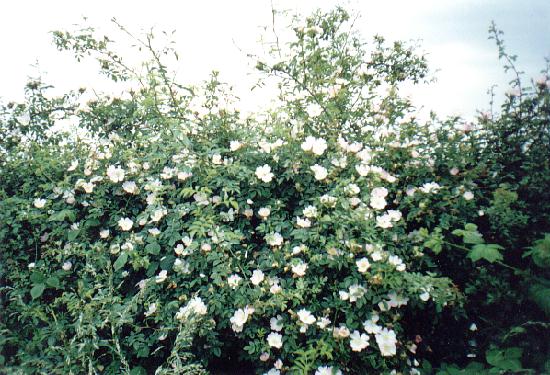
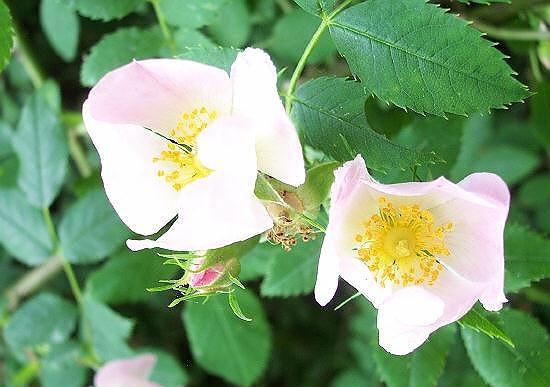
|
|
Wild roses in the
hedgerow alongside a narrow country road
near Hanthorpe (above) and in Bourne Wood (below) |
|
Wild roses proliferate in the Bourne area during May and June. They are all around us, in the woods and in the hedgerows along the roadside verges, and they look so fragile yet some have the most delicate and exquisite
scent but it is dangerous to pick them because they are protected by razor-sharp, hooked prickles that can tear into the skin of the unwary.
There are several species but the most familiar is the dog-rose (Rosa
canina). This wild ancestor of the garden rose was the symbol of the Tudor kings of England but it is thought to derive its name from an ancient Greek belief that it would cure a person who had been bitten by a mad dog. The flowers can be shell-pink or white and their stems arch and scramble in the hedgerow and twine their way around the trees in the woods. When the petals fall, red berry-like fruit or hips form and these can be made into jelly and syrup because they are rich in Vitamin C. During World War Two, when nourishing food was scarce, the government sent us kids out into the hedgerows to collect them and in 1943 alone, some 500 tons of rose hips were amassed in this way and processed to provide children with rose hip syrup as a supplement to the meagre diet that resulted from food rationing. Today, this vast natural commodity is left to the birds. |
|

|
|
Tree mallow
flowering in profusion along the footpath in Tennyson Drive |
|
One of the most colourful and prolific shrubs of the urban street scene is rosea or tree mallow
(Lavatera olbia) that can reach heights of seven feet. This is a sub-shrub, that is one where the soft top dies back annually, and many gardeners regard them as no better than weeds, but during the summer months they produce large and attractive, shallow, trumpet-like flowers, pink in colour. They present a most attractive sight and
one of the best displays in the locality has been been planted
alongside the path in Tennyson Drive, the main road into the new
housing development now under construction on a greenbelt site off
the main A15 road south of Bourne. It is to be hoped that this is not just window dressing to attract potential home buyers and when the developers move out, the flowers and shrubs they have planted with such care to enhance the area will not be left to become overgrown and unsightly. |
|
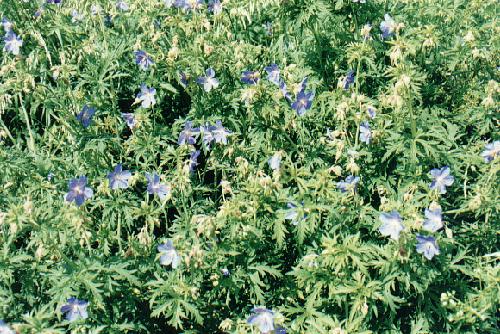
|
|
Meadow crane's bill
on the roadside verges south of Wilsthorpe village |
|
Like many of our wild
flowers, meadow crane's bill (Geranium pratense) is no
longer a common sight in the countryside around Bourne although
there are places where clumps can still be seen between June and
September struggling to survive the ravages of intensive
agriculture. This is a strikingly beautiful perennial of summer
meadows and grassy roadsides with bold, deeply-lobed leaves and
large bluish-violet flowers. The name crane's bill comes from the
long beak-like protrusion attached to the seed vessel and when
ripe, this splits into coiling spirals that jerk the seeds out and
so assist their distribution to perpetuate the species. |
|
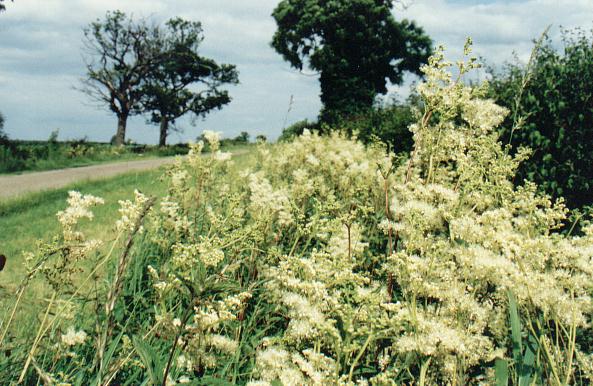
|
|
Meadowsweet on the
roadside verges near Swinstead |
|
Patches of meadowsweet (Filipendula
ulmaria) can be found in damp meadows but more likely around
Bourne along the moist verges of country roads and its pungent
bitter-sweet smell invades the open windows of the car as you
pass, a reminder that high summer is here. This perennial, which is
also known as Queen of the Meadow, is a tall and erect plant
with frothy heads of small creamy-white flowers that can be seen
from June until September and in past times was used as a sort of
air freshener, strewn on the floors of houses to produce a tangy
but pleasant odour indoors, while the flowers were also picked to
flavour meals and to make herbal teas. Meadowsweet was also
formerly used to ward off malaria when forms of that disease were
common on undrained lowland areas of South Lincolnshire. |
|
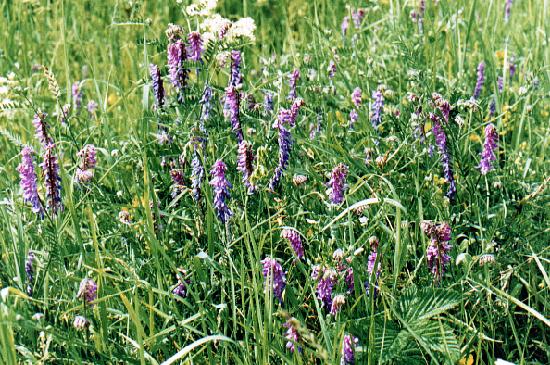
|
|
Tufted vetch on the
roadside verge near Stainfield |
|
Tufted vetch (Vicia
craccca) looks a tall and elegant perennial but in reality it
is a weak-stemmed plant that gains support by clambering over
other vegetation and climbs high through tall grass and hedgerows
by means of branched tendrils at the tops of ladder-like leaves.
The slender spires of small pea flowers open a rather pale purple
in colour but fade to a deep violet-blue and can be seen from June
to August. Vetches are closely related to beans and peas and were
once grown for fodder and examples have colonised many a field's
edge. |
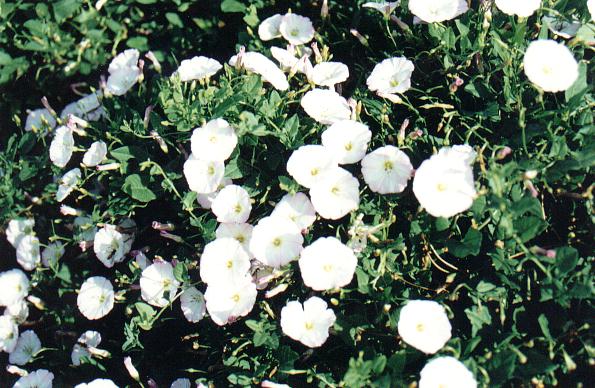 |
|
Field bindweed
climbing in the hedgerow on the outskirts of Manthorpe |
|
Field bindweed (Convolvulus
arvensis) is a climbing plant with delightful pink and white,
candy-striped flowers, its funnel-shaped petal tube opening
fan-like by day and attracting many sorts of insects. It
flowers from June to September and can be found growing on waste
ground such as rubbish tips and railway ballast, around the base
of electricity pylons and fences and along roadside verges. The
long radiating stems of field bindweed spread anti-clockwise in a
circle and sometimes twist together, using each other for
support. This species is unwelcome in gardens because it is has
extremely invasive underground stems and is regarded as a stubborn
weed but still looks very attractive when found growing in
profusion in country areas. |
|
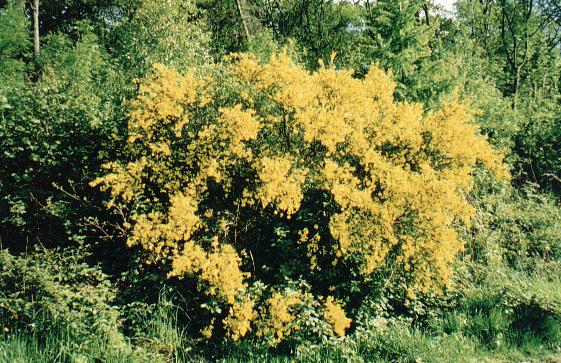
|
|
A rare sight in
Bourne Woods, a broom bush by the side of a woodland track |
|
Broom (Sarothamnus
scoparius) is an evergreen shrub similar to gorse that can be
found on heaths, dunes and in woods in many parts of Britain but
there are few in this locality. Its golden scented flowers are
favoured by bees and on being touched, they expel pollen on to the
undersides of visiting insects. The long, supple branches were
once made into brooms for sweeping, hence the name which is
derived from the Old English, while the medicinal uses of the
brush-like branches are recorded in herbals as early as the 15th
century. It was also used as an heraldic device, notably as the
badge of Brittany, and is also associated with several popular
traditions, including the use of the flowering tops for
house decorating at Whitsuntide festivals. |
|
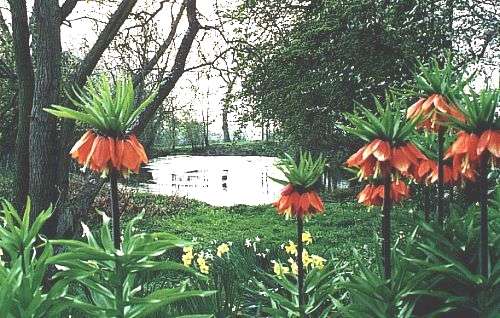
|
|
Crown Imperial
growing around the village pond at Sapperton during April |
|
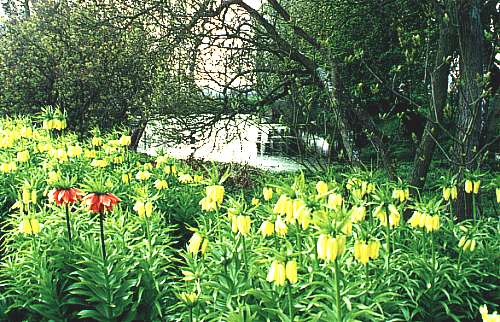
|
|
Crown Imperial (Fritillaria
imperialis) are the most unlikely flowers to be found growing
in the wild and it is worth a trip to Sapperton, north of Bourne,
in spring just to see them. This flower is a type of fritillary, a
member of the lily family and native to Turkey, scattered from
there as far as Kashmir. They have both orange and yellow forms
and are tolerant to our temperate climate and have been planted
here by local residents to give extra colour to the village pond. |
|
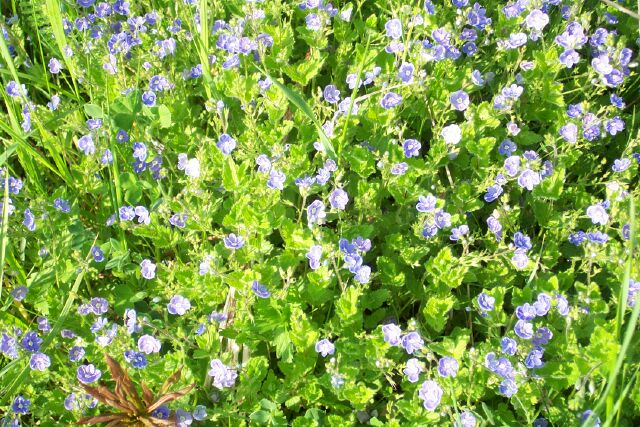
|
|
Germander speedwell
along the old railway line near Dyke |
|
Small bright blue flowers can be found in grassy places, hedges and woods between March and July and this delightful plant
is the germander speedwell
(Veronica chamaedrys). There are many other country names such as Eye of Christ, Cat's Eye, Bird's Eye and Farewell. It is the commonest of the British species of speedwell and we found these growing along the route of the old railway line between Bourne and Dyke village, now a narrow wildlife corridor through arable land but becoming more overgrown with the passing years and impassable in some places, but still walked by those who are anxious to keep it open as a footpath. The flowers close at night and in rainy weather when the brightness of the blossom disappears and only the pale and pearly underside of its petals are visible. It was valued in past times for its medicinal properties, as a vulnerary, a purifier of the blood, a remedy for various skin diseases, a cure for smallpox and measles and as a panacea for many other ills. It also has a certain amount of astringency and an infusion of its leaves was once famous for coughs. |

Go to:
Main Index Villages
Index
|






































